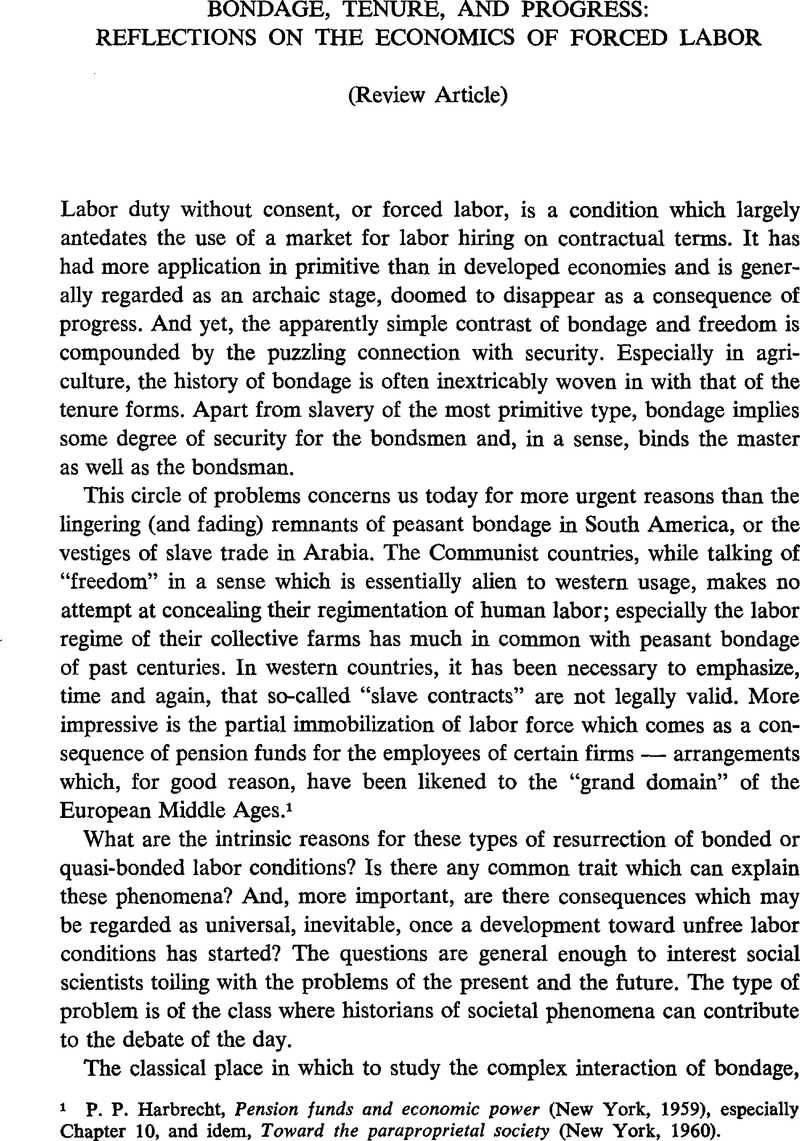Article contents
Bondage, Tenure and Progress: Reflections on the Economics of Forced Labor
Published online by Cambridge University Press: 03 June 2009
Abstract

- Type
- Slavery and Bondage
- Information
- Copyright
- Copyright © Society for the Comparative Study of Society and History 1965
References
1 Harbrecht, P. P., Pension funds and economic power (New York, 1959),Google Scholar especially Chapter 10, and idem, Toward the paraproprietal society (New York, 1960).Google Scholar
2 Confino, M., Domaines et seigneurs en Russie vers la fin du 18e siècle. Etude de structures agraires et de mentalités économiques. (= Collection historique de I'lnstitut d'Etudes slaves, 18) (Paris, 1963).Google Scholar Preface de Hvitfeldt, R. Portal. J., Kampen om ophaevelsen af livegenskabet i Slesvig og Holsten, 1795–1805. (= Skrifter udg. af Historisk Samfund for Sønderjylland, 29) (Copenhagen, 1963).Google Scholar In Danish, with a summary in Poni, German. C., Gli aratri e I'economia agraria nel Bolognese dal 17 al 19 secolo (Bologna, Zanichelli, 1963).Google Scholar
3 Some of the largest estates used mainly rent; see for instance Indova, E. I., Krepostnoe khoziàĭstvo v nachale xix veka. Po materialam votchinnogo arkhiva Vorontsovykh (Moscow, 1955). Reference is made to the "Free Economic Society", p. 5, to other 19th century writers, pp. 5 sqq. The study is based on the archives of the Vorontsov family and portrays a very large system of estates, with tens of thousands of serfs and hundreds of thousands of det'iatiny. The modes of operation are described pp. 47 sqq., the rental system p. 178 sqq.Google Scholar
4 See, for instance, Krepostnaia manufaktura v Rossii (= Akad. Nauk SSSR, Trudy istoriko-arkheologicheskogo instituta, T. 13) (Moscow in the early thirties, Chast 5, 1934).
5 Rashin, A. G., Naselenie Rossii za 100 let (1811–1913 gg.) (Moscow, 1956), p. 98.Google Scholar
5 On the manorial system in Denmark, see Olsen, G., Hovedgard og bondegard. Studier over stordriftens udvikling i Danmark 1525–1774 (Copenhagen, 1957).Google Scholar
5 Also in the western German areas in general, bondage was uneven both in occurrence and in character, and its abolition stretched over long periods of time. A useful summary, with bibliographical notes, in Conze, W., “En Europe Centrale: L'émancipation des paysans d'aprés de récents travaux Allemands”, in Cahiers d'histoire mondiale, Vol. I, No. 1 (Paris, 1953, 07), pp. 179–194.Google Scholar
8 The exception was Franche-Comté, which had become part of the French kingdom at a late date; and even there, the vestiges of feudal mainmorte were far from amounting to genuine bondage. Cf. Millot, J., Le régime féodal en Franche-Comté au XVIIIe siécle (Besançon, 1937).Google Scholar
9 Cf. Vaccari, P., L'affrancazione dei servi della gleba nell'Emilia e nella Toscana (Bologna, 1925).Google Scholar
- 3
- Cited by




